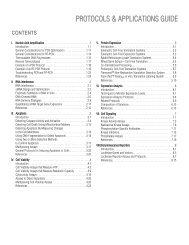2012 Promega catalogue
2012 Promega catalogue
2012 Promega catalogue
You also want an ePaper? Increase the reach of your titles
YUMPU automatically turns print PDFs into web optimized ePapers that Google loves.
Life<br />
Science<br />
Catalog<br />
<strong>2012</strong><br />
Worldwide Contact List<br />
Section<br />
Contents<br />
Table of<br />
Contents<br />
Cell Signaling<br />
142<br />
DPPIV-Glo Protease Assay<br />
Product Size Cat.# Price ($)<br />
DPPIV-Glo Protease Assay 10 ml G8350 490.00<br />
For Laboratory Use.<br />
50 ml G8351 1267.00<br />
Description: The DPPIV-Glo Protease Assay is a homogeneous, luminescent<br />
assay that measures dipeptidyl peptidase IV (DPPIV) activity. DPPIV is a serine<br />
protease that cleaves N-terminal dipeptides from polypeptides with L-proline<br />
or L-alanine at the penultimate position. The DPPIV-Glo Assay provides a<br />
proluminescent DPPIV substrate, Gly-Pro-aminoluciferin, in a buffer system<br />
optimized for DPPIV and luciferase activities. The addition of a single<br />
DPPIV-Glo Reagent in an “add-mix-measure” format results in DPPIV<br />
cleavage of the substrate and generation of a “glow-type” luminescent signal<br />
produced by the luciferase reaction. In this homogeneous, coupled-enzyme<br />
format, the signal is proportional to the amount of DPPIV activity present. The<br />
assay is designed for use with purified enzyme preparations.<br />
Features:<br />
• Simplified Method: The homogeneous “add-mix-measure” protocol<br />
makes the assay highly amenable to automation.<br />
• Greater Sensitivity: The assay is more sensitive than fluorescent-based<br />
DPPIV assays. In contrast to fluorescent assays, the luminescent assay<br />
avoids inherent fluorescent background signals and thus provides excellent<br />
signal-to-background readings. The assay is linear over more than 3 logs<br />
of DPPIV concentration and can detect less than 1pg/ml enzyme.<br />
• Faster Results: The maximum signal (and maximum sensitivity) of the<br />
assay is reached in as little as 30 minutes after reagent addition and,<br />
unlike fluorescent assays, is not dependent on accumulation of cleaved<br />
product.<br />
• Amenable to Batch Processing: The stability of the signal allows plates<br />
to be read over an extended period of time.<br />
Storage Conditions: Store components at –20°C protected from light.<br />
Protocol Part#<br />
DPPIV-Glo Protease Assay Technical Bulletin TB339<br />
Signal-to-Noise Ratio<br />
100,000<br />
10,000<br />
1,000<br />
100<br />
10<br />
1<br />
Gly-Pro-aminoluciferin<br />
Gly-Pro-AMC<br />
0.1<br />
0.0001 0.001 0.01<br />
DPPIV (ng/ml)<br />
0.1 1<br />
Sensitivity of the DPPIV-Glo Protease Assay compared to a<br />
fluorescent assay.<br />
4799MA<br />
Proteasome-Glo Assays<br />
Product Size Cat.# Price ($)<br />
Proteasome-Glo Chymotrypsin-Like Assay 10 ml G8621 490.00<br />
50 ml G8622 1267.00<br />
Proteasome-Glo Trypsin-Like Assay 10 ml G8631 490.00<br />
50 ml G8632 1267.00<br />
Proteasome-Glo Caspase-Like Assay 10 ml G8641 490.00<br />
50 ml G8642 1267.00<br />
Proteasome-Glo 3-Substrate System 10 ml G8531 1226.00<br />
For Research Use Only. Not for Use in Diagnostic Procedures.<br />
50 ml G8532 Pls. Enq.<br />
Description: The Proteasome-Glo Assays are homogeneous, luminescent<br />
assays that individually measure the chymotrypsin-like, trypsin-like and<br />
caspase-like protease activities associated with the proteasome in an<br />
enzyme-based format. The 26S proteasome is a 2.5MDa multiprotein complex<br />
found in all eukaryotic cells. Proteasome-Glo Cell-Based Assays provide<br />
luminogenic proteasome substrates in buffers optimized for cell<br />
permeabilization, proteasome activity and luciferase activity. Addition of the<br />
Proteasome-Glo Cell-Based Reagent in an “add-mix-measure” format<br />
results in proteasome cleavage of the substrate and rapid generation of a<br />
luminescent signal produced by the luciferase reaction.<br />
The three luminogenic substrates used to monitor specific protease activities<br />
include: Suc-LLVY-aminoluciferin for chymotrypsin-like, Z-LRR-aminoluciferin<br />
for trypsin-like, and Z-nLPnLD-aminoluciferin for caspase-like activity. Each<br />
luminogenic substrate is added to a buffer system optimized for its specific<br />
proteasome activity and luciferase activity. The reagents are added to test<br />
samples containing proteasome enzyme that cleaves the substrates, releasing<br />
luciferin, which is consumed by luciferase, producing “glow-type” luminescence<br />
correlating to enzyme activity or inhibition.<br />
The Proteasome-Glo 3-Substrate System consists of three<br />
homogeneous bioluminescent assays in an enzyme-based format (each of<br />
these three assays also is available separately).<br />
The Proteasome-Glo Cell-Based 3-Substrate System consists of three<br />
homogeneous bioluminescent assays that measure the three proteolytic<br />
activities associated with the proteasome in a cell-based format (each of these<br />
three assays also is available separately).<br />
Features:<br />
• Simplified Method: The “add-mix-measure” protocol minimizes handling<br />
steps and makes the assays amenable to automation.<br />
• Faster Results: Maximum sensitivity is reached 10–30 minutes after<br />
reagent addition.<br />
• Greater Sensitivity: The luminescent assay format avoids inherent<br />
fluorescent background signals, providing excellent signal-to-background<br />
readings. The assays are miniaturizable to 384-well format.<br />
Storage Conditions: Store the Proteasome-Glo Assay components at<br />
–20°C.<br />
Protocol Part#<br />
Proteasome-Glo Assay Systems Technical Bulletin TB349<br />
For complete and up-to-date product information visit: www.promega.com/catalog
















